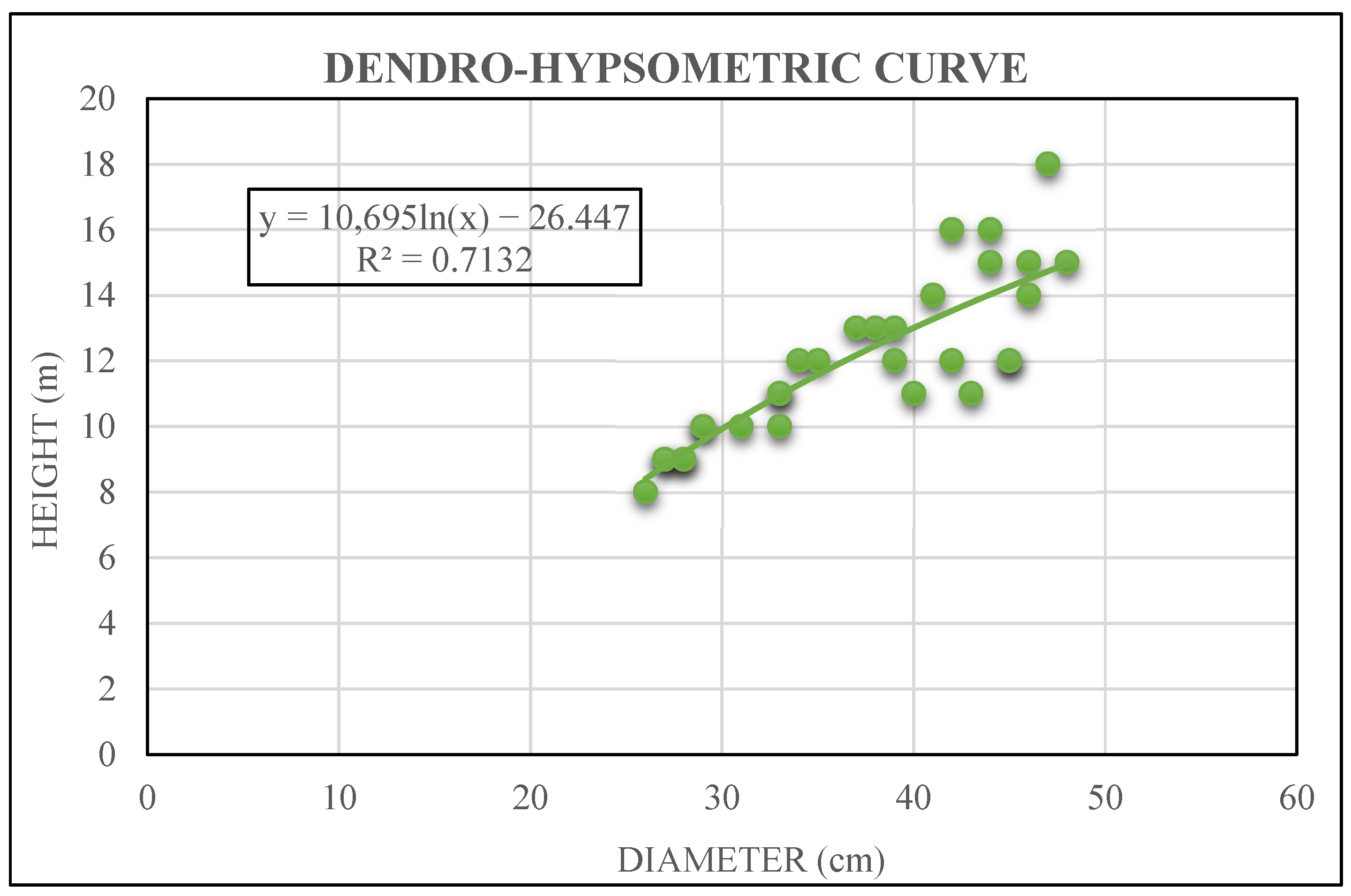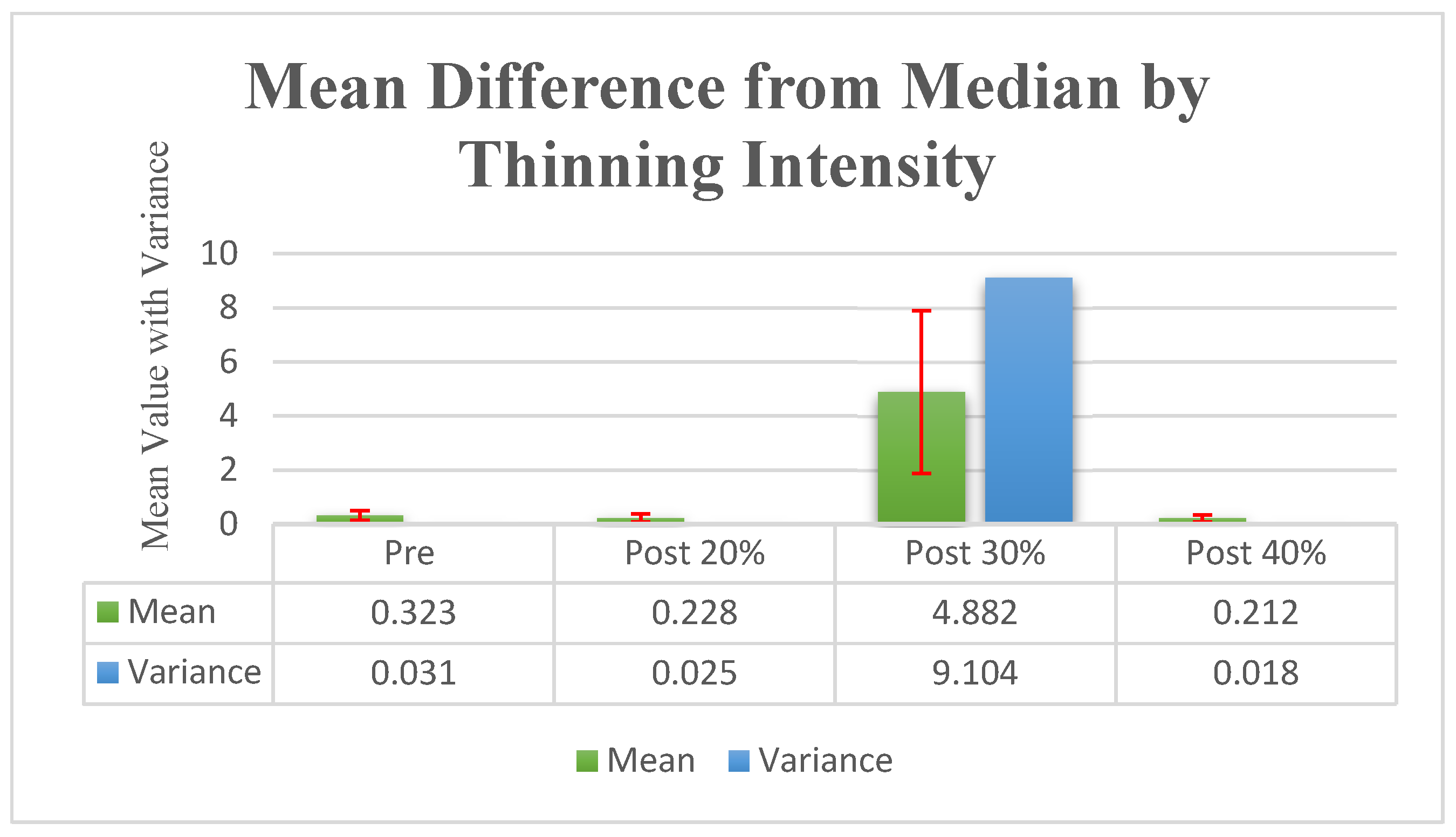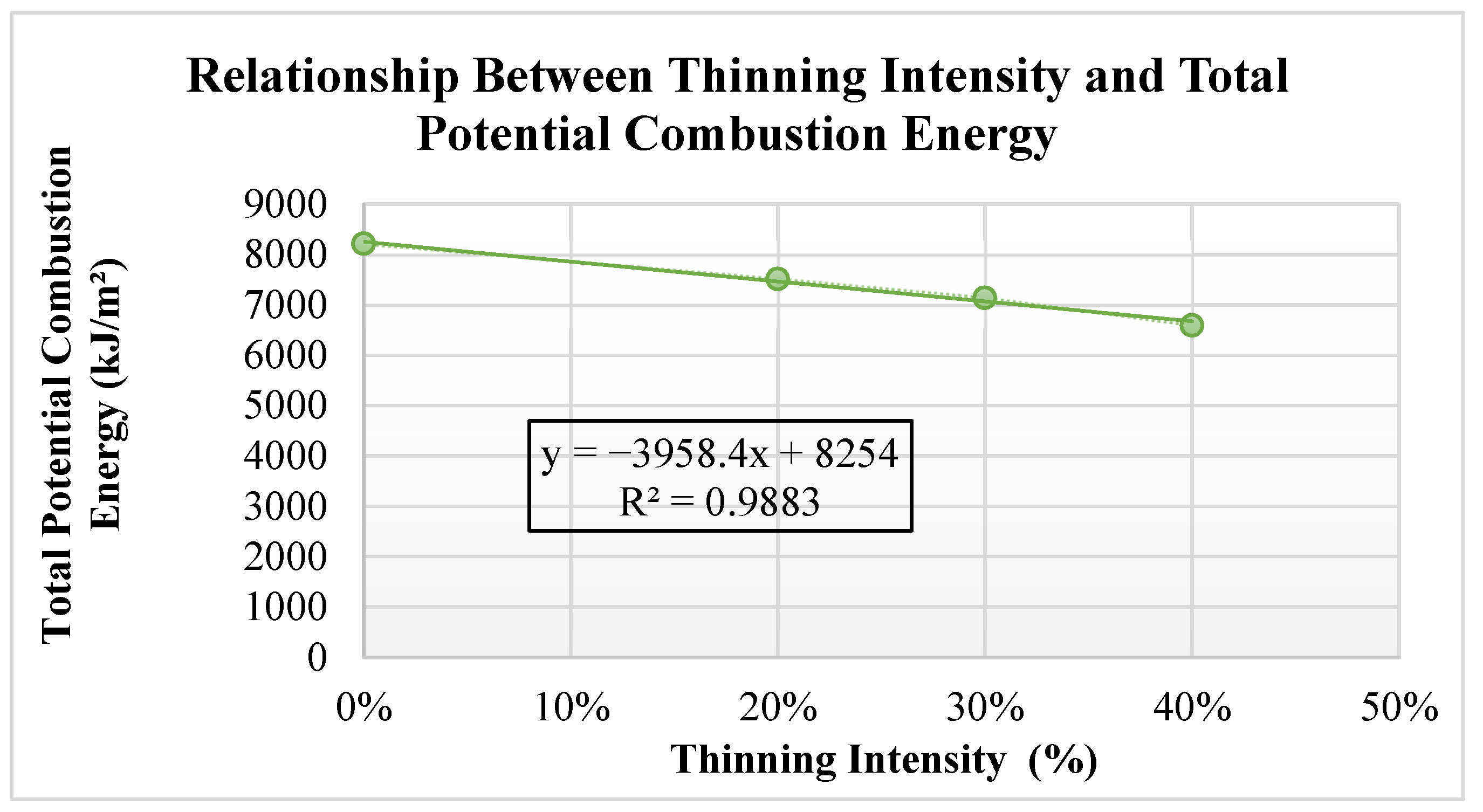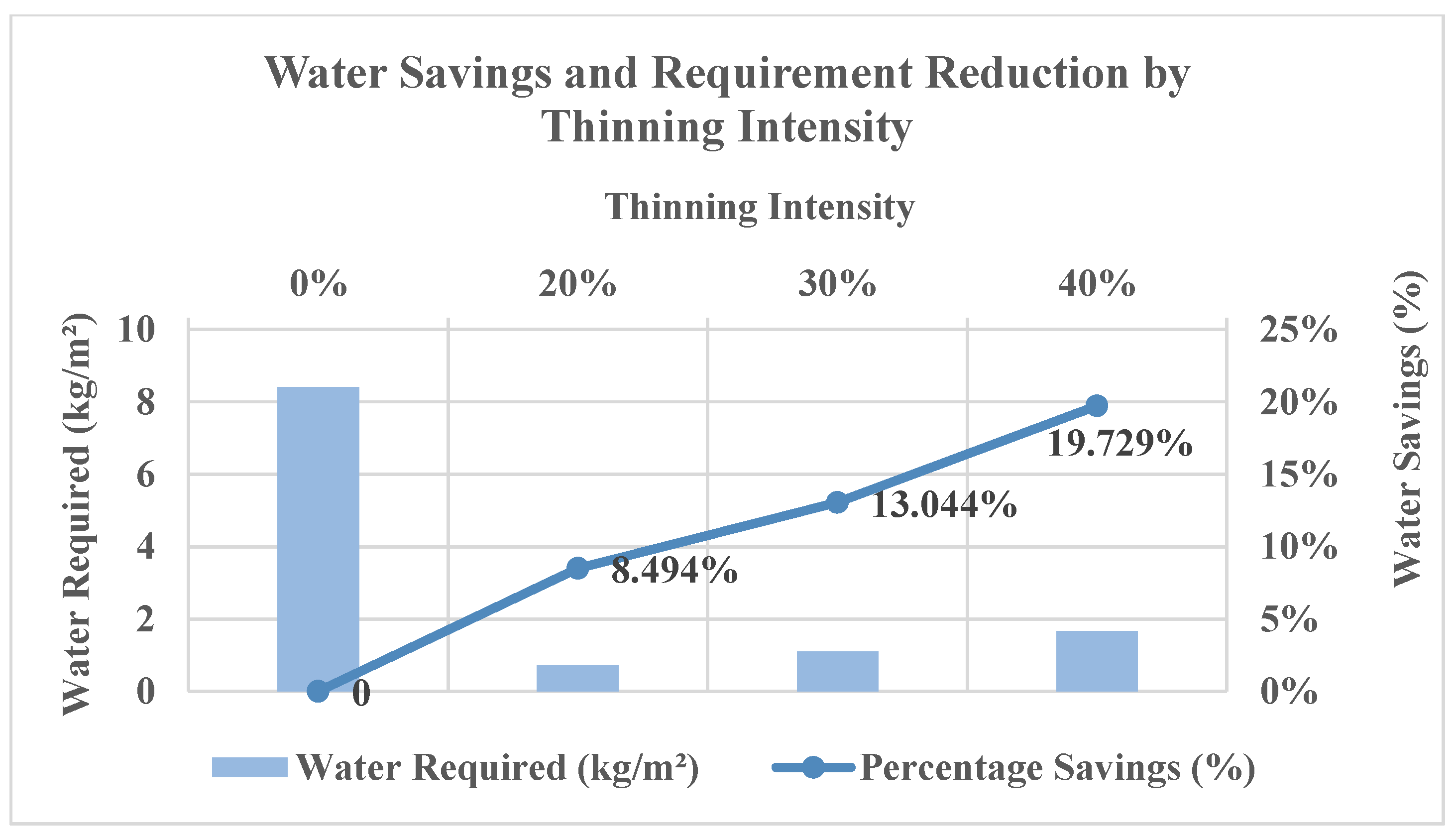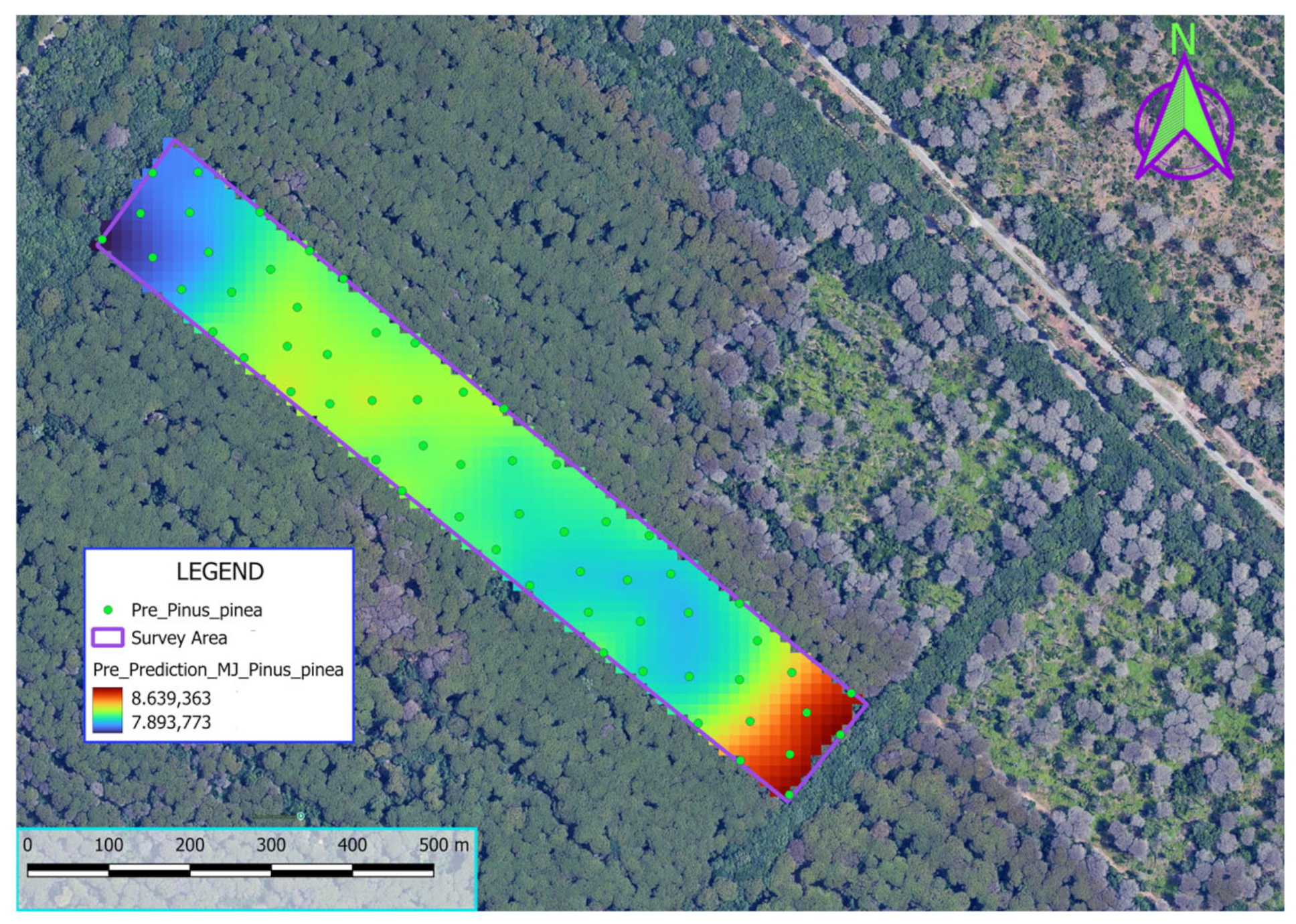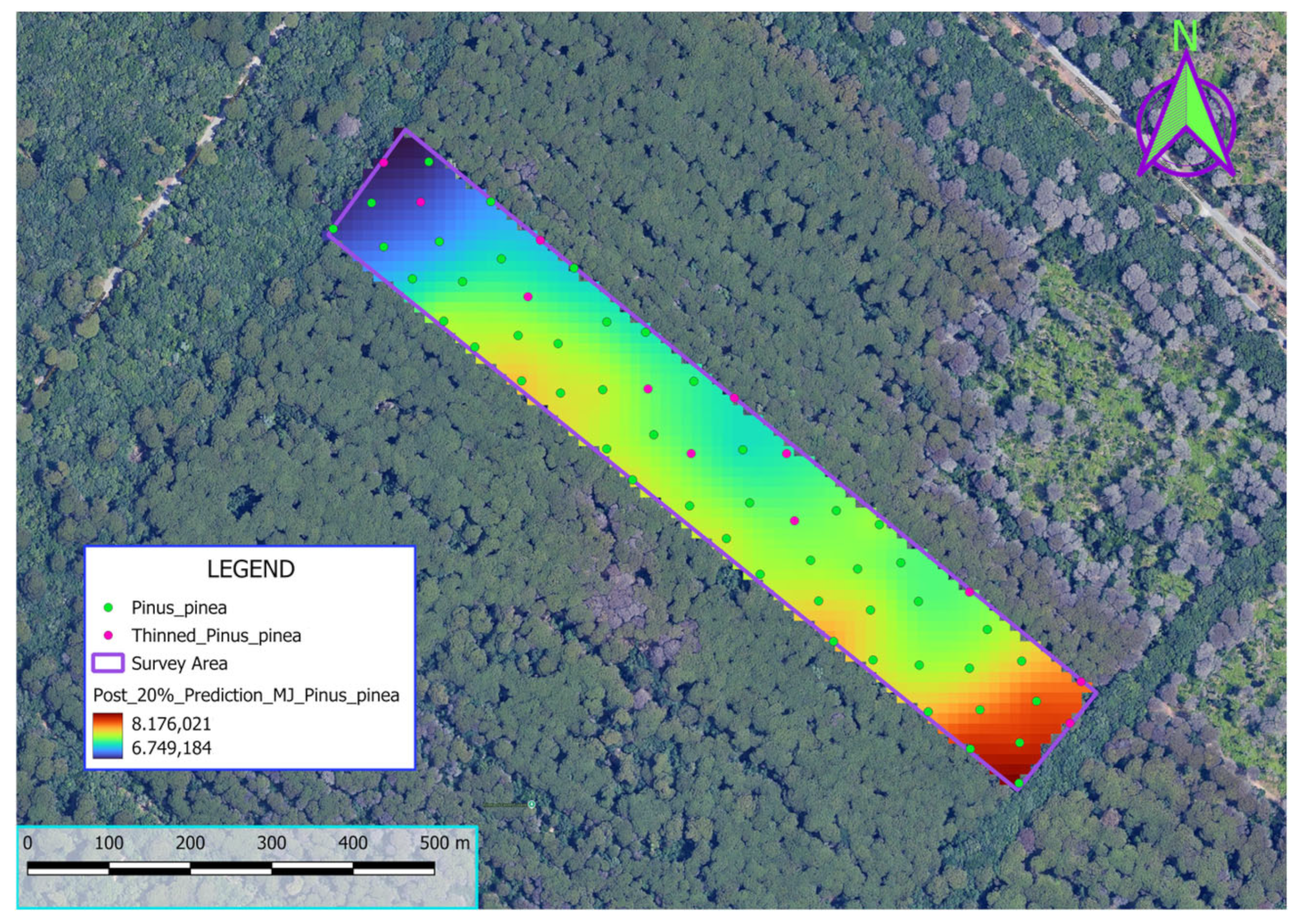1. Introduction
Forest ecosystems in Mediterranean regions are increasingly threatened by wildfires, intensified by climate change and anthropogenic pressures [
1]. Silvicultural interventions, such as thinning, are widely recognized as effective measures to reduce biomass fuel loads and mitigate fire risks [
2]. However, optimizing thinning intensity is challenging, as it requires balancing environmental, economic, and safety concerns.
Numerous studies have emphasized the importance of silvicultural interventions, such as thinning and biomass removal, to reduce fire hazards [
3]. For example, “Silvicultural Prevention and Mathematical Models for Predicting Fire Propagation in Southern Italy” [
4] demonstrated that thinning in pine stands reduced thermal energy by 17–21%, while also reducing the likelihood of surface fires transitioning to crown fires by up to 31%. This study highlighted the importance of optimizing thinning intensities to reduce fire risk but also pointed out that many existing practices lack precision or scalability in their application.
Previous studies have explored various thinning strategies, often emphasizing their effectiveness in reducing fuel loads or altering fire behavior [
5]. However, few have integrated spatial analysis methods to quantify the distribution of calorific energy and its reduction across large-scale forest landscapes. This study addresses this gap by introducing an evaluation framework that combines field data, geospatial techniques (Ordinary Kriging), and statistical analyses to assess the impact of thinning on energy distribution and water savings [
6].
This approach is novel in its capacity to spatially analyze thinning impacts at varying intensities, offering measurable insights into energy load reduction and resource efficiency. By applying this method in a Mediterranean forest context, the study not only advances current silvicultural practices but also informs fire risk management strategies and resource optimization policies.
2. Materials and Methods
2.1. Study Area
The study was conducted in the Pineta di Castel Fusano, a Roman pine forest located in the municipality of Rome, Italy. The region’s susceptibility highlights the need for effective forest management strategies [
7]. This forest has faced significant wildfire events over the years, making it an ideal location for evaluating the effectiveness of silvicultural interventions aimed at reducing combustion energy load. The forest is characterized by a Mediterranean climate, with hot, dry summers and mild, wet winters. The vegetation is predominantly made up of
Pinus pinea trees, interspersed with Mediterranean maquis, including species such as
Quercus ilex and
Juniperus phoenicea.
Due to its flammable vegetation and the region’s climatic conditions, the forest is particularly vulnerable to wildfire. The area’s susceptibility has been highlighted by several major fires that have severely impacted the ecosystem. Notably, the forest was struck by a large wildfire in 2000, which burned 300–350 hectares, with 280 hectares being destroyed. Other significant fires followed in 2002, 2003, 2004, and 2005, further depleting the forest’s coverage without effective replanting efforts. More recently, 2017 witnessed another devastating fire, burning approximately 100 hectares of the pine forest.
These frequent wildfires, exacerbated by the region’s climatic conditions, emphasize the urgent need for optimized forest management strategies. This study aims to address this challenge by testing silvicultural interventions that could reduce wildfire risks and improve the forest’s resilience.
2.2. Methodology
To evaluate the impact of different thinning intensities on combustion energy load, a simulation-based approach was adopted. This approach focused on the analysis of dendrometric and pyrolitic variables, leveraging both Excel for data analysis and QGIS for spatial visualization.
2.3. Simulation Design
The simulations were performed on a sample of 60 Pinus pinea trees, selected as representative of the dominant species within the forest stand. Three intercalary thinning scenarios were analyzed, with intensities of 20%, 30%, and 40%. For the analysis of the characteristics of interest of the Pinus pinea sample area, calculations were performed at two distinct time points: before and after the silvicultural intervention. These steps were repeated for each thinning scenario, allowing for a direct comparison between the pre- and post-intervention situations, corresponding to a 10-year rotation period, with the harvesting of 12, 18, and 24 out of 60 trees for the 20%, 30%, and 40% thinning intensities, respectively. Data on tree diameter, height, biomass, specific weight, and higher calorific value were used to calculate the potential reduction in combustion energy load under each thinning scenario.
This methodology draws on evidence from prior studies that emphasize the significant role thinning intensity plays in influencing fire dynamics. For example, ref. [
2] demonstrated that thinning intensities between 20% and 30% effectively mitigate fire propagation risk in Mediterranean forests while preserving stand structure. Similarly, ref. [
5] highlighted that moderate thinning within this range significantly reduces fuel loads, enhancing fire resilience without compromising ecological functions.
2.4. Simulation Framework
The study utilized a simulation-based approach to evaluate the impact of different silvicultural interventions on reducing combustion energy load in the forest ecosystem.
2.4.1. Tree Volume
The volume of the sampled trees was calculated using a double-entry allometric method for volume estimation, which considers both the diameter (D) and height (H) of each tree. The formula used is as follows:
where the components are defined as follows:
V is the volume of the tree in m3;
D is the diameter of the tree in cm;
H is the height of the tree in m;
b1 = −0.40404b1 is the intercept coefficient;
b2 = 0.041113 is the coefficient for the diameter squared and height.
This method was applied to all 60 sampled trees. The formula was derived from [
8] in their work. The formula assumes a strong correlation between diameter and height, with the dendro-hypsometric curve providing an r
2 value of 0.71, indicating a good fit between the two variables (see
Figure 1). This method allows for accurate volume predictions by integrating both tree dimensions (diameter and height) into a single predictive model.
2.4.2. Aboveground Biomass Weight per Hectare
The total volume was scaled up to represent biomass per hectare and for the entire study area of 60,000 square meters (6 hectares). The specific weight of air-dried
Pinus pinea wood with a moisture content of 12–15% (tabulated value) was then applied. The total volume of the sample trees was multiplied by the specific weight of
Pinus pinea (kg/m
3) to determine the amount of aboveground biomass, in kg/ha, that could potentially be consumed by fire in the study area. The formula used is as follows:
where the components are defined as follows:
ΣVh: the total volumetric sum per hectare of the trees (m3 * 1 ha);
S.A: the total survey area (m2);
ρ: the specific weight of Pinus pinea (620 kg/m3);
Βabv: the aboveground biomass weight per hectare (kg/ha).
Subsequently, the difference between this total pre-intervention value and the post-intervention values for each scenario was calculated to determine the amount of aboveground biomass removed according to the intensity of the silvicultural intervention.
2.4.3. Higher Calorific Value
As emphasized in the study by [
2], and in agreement with [
9], the higher calorific value (HCV) of coniferous species is closely linked to wood moisture content, with the calorific value decreasing as moisture content increases:
At 5% moisture content, the HCV is 18.84 MJ/kg.
At 30% moisture content, the HCV decreases to 15.28 MJ/kg, reflecting a 19% reduction.
At 100% moisture content, the HCV further decreases to 9.84 MJ/kg, corresponding to a 48% reduction.
According to [
5], the higher calorific value (HCV) of Pinus wood with a moisture content of 12–15% is 17,800 kJ/kg. This value was validated through comparative analysis with other species, such as
Pinus pinaster (maritime pine), which demonstrates similar pyrolytic behavior. For
Pinus pinea (stone pine), HCV estimates were derived by interpolating values for moisture contents of 5% and 30%, yielding the following results:
At 12% moisture content, the HCV was approximately 17.84 MJ/kg;
At 15% moisture content, the HCV was approximately 17.42 MJ/kg.
These estimates align well with the observed values and further reinforce the reliability of the data used in calculating the energy potential of forest biomass, with the value proposed by [
5] being utilized for the calculation procedures.
2.4.4. Calorific Energy
To estimate the calorific energy (Ecal), the aboveground biomass (Βabv) was converted from kilograms per hectare (kg/ha) to kilograms per square meter (kg/m2) by dividing the biomass value by 10,000 m2, equivalent to one hectare. This conversion allowed for an area-specific calculation of the energy potential.
The calorific energy content of the biomass was calculated using the following formula, in accordance with [
2,
3,
5,
7,
9,
10]:
where the components are defined as follows:
Ecal: calorific energy (kJ·m−2), representing the ecosystem’s energy load.
Βabv: aboveground biomass per unit area (kg·m−2).
HCV: higher calorific value of the biomass (kJ·kg−1).
This method enabled the calculation of the total thermal energy present in the ecosystem prior to thinning operations and the energy removed under each thinning scenario (20%, 30%, and 40%). By quantifying the reduction in combustion energy load, this approach provides a direct measure of the effectiveness of silvicultural interventions in mitigating wildfire risk and intensity.
2.4.5. Water Fire Suppression
Finally, the fire extinction formula from [
11,
12] was applied to the total calorific energy not removed to estimate the amount of water required to extinguish the fire in case it affected the study area without any silvicultural intervention. Subsequently, the amount of water saved was calculated for the different intensities of silvicultural thinning scenarios. Water savings were calculated using the following equation:
where the components are defined as follows:
AH2O: quantity of water needed to absorb the heat energy produced during the combustion (kg·m−2).
Ecal: calorific energy (kJ/m2).
β: efficiency coefficient, defined as the ratio between the amount of water effectively applied to the fire that undergoes complete vaporization and the total amount of water delivered. This coefficient represents the efficiency of the fire suppression process. Practical and experimental considerations [
10] suggest that β is typically low, not exceeding values of 0.6–0.7. According to the literature [
11,
12], β can generally be assumed to be 0.4.
Δhw: Latent heat of evaporation of water at 100 °C = 2440 kJ/kg.
2.4.6. Geospatial Analysis
The spatial distribution of the 60 sampled trees within the study area was mapped using QGIS version 3.34.14 [
13]. The calorific energy of each tree (in megajoules, MJ) was calculated based on the total stem volume (m
3), specific wood density (kg/m
3), and the higher calorific value (HCV, kJ/kg) for the specific tree species. This energy was recorded in the attribute table and spatialized using the “Processing Saga NextGen Provider” plugin, version 1.0.0 [
14], and SAGA GIS version 9.1.2 [
15]. The calorific energy was calculated with the following formula:
where the components are defined as follows:
Ecal: calorific energy produced by the tree biomass (MJ), representing the energy released during combustion.
V: total stem volume of the tree (m3) estimated using the previous standard dendrometric equations.
ρ: specific weight (kg/m3), indicating the average wood density of the tree species.
HCV: higher calorific value (kJ/kg), derived from previously published studies for the specific species.
103: conversion factor to express energy in gigajoules (MJ) from kilojoules (kJ).
For spatialization, Ordinary Kriging was applied [
16] to interpolate spatially correlated data. This method was initially used to create a baseline visualization of calorific energy distribution in the study area before (see Figure 6) any silvicultural intervention.
In the post-thinning scenario (20% thinning intensity), the same methodology was applied to the remaining 42 trees. The spatialization process was repeated using the same Ordinary Kriging tool and the same linear model to maintain methodological consistency (see Figure 7). To assess the effect of thinning on calorific energy distribution, the Zonal Statistics Raster tool was employed to calculate and compare the average energy values for both the pre- and post-thinning scenarios.
3. Results
3.1. Effect of Thinnings on Tree Volume
This study provides a detailed analysis of the impact of various thinning treatments on forest biomass, comparing volumes measured before and after applying treatments with intensities of 20%, 30%, and 40%. Analysis of variance (ANOVA) and t-tests were employed to evaluate the differences between groups, revealing that treatment intensity significantly influences volume reduction. The 40% treatment exhibited the most significant difference (p < 0.01), suggesting that higher intensity had a marked effect on volume. In contrast, treatments with 20% intensity did not show a significant effect (p > 0.05), indicating that such a treatment level may not substantially impact biomass.
The results from the t-test further highlight the differences between the 20%, 30%, and 40% thinning treatments. For 20% thinning, statistical analysis revealed no significant change in tree volume (p > 0.05). However, the 30% and 40% thinning treatments showed significant reductions in tree volume. The 30% thinning treatment exhibited a highly significant reduction (p < 0.001), while 40% thinning also led to a substantial decrease in volume (p < 0.001). These results suggest that thinning treatments with intensities higher than 20% lead to more considerable reductions in tree volume.
From the perspective of sustainable forest management, the results indicate that thinning treatments with intensities between 20% and 30% may represent the most effective solution for reducing biomass impact (
Figure 2). This intensity range provides an optimal balance between volume reduction and the need to maintain ecological stability within the forest ecosystem. Furthermore, these treatments are known to improve forest resilience to disturbances such as fire while preserving the forest’s biodiversity and ecological integrity.
In conclusion, while higher-intensity treatments lead to more pronounced effects on biomass reduction, treatments within the 20–30% range offer a sustainable approach to forest management. These treatments reduce ecological impact, enhance fire resilience, and maintain the ecological functions essential for long-term forest health.
3.2. Effect of Thinning on Combustion Energy Reduction
Selective thinning significantly impacted the reduction in total potential combustion energy (PCE). The results show that at a thinning intensity of 20%, the reduction in PCE was 8.494% compared to the pre-treatment scenario. With an increase in thinning intensity to 30%, the reduction reached 13.044%, while at a 40% thinning intensity, the reduction percentage increased to 19.729%.
The graph (
Figure 3) clearly illustrates these reductions, highlighting a consistent trend: as thinning intensity increases, the biomass energy load decreases proportionally.
This demonstrates the effectiveness of thinning as a fire risk mitigation strategy.
However, it is important to consider that while higher thinning intensities lead to greater reductions in PCE, they may also negatively impact the ecological and structural stability of the forest ecosystem. Therefore, a 20–30% thinning intensity range represents an optimal compromise, balancing fire risk reduction with the conservation of ecosystem resilience. These findings align with the literature, where studies have shown that thinning can reduce fuel accumulation and decrease the likelihood of catastrophic fires.
For example, ref. [
2] highlights that thinning reduces fuel load and enhances forest resilience to fire. Additionally, ref. [
16] confirmed that moderate thinning practices help reduce the risk of catastrophic fires without compromising forest health. By managing thinning intensities, it is possible to reduce potential combustion energy, contributing to both fire resilience and overall forest health. This aligns with the goals of sustainable forest management, which seeks to balance forest structure and ecological functions while mitigating risks such as wildfires [
1].
3.3. Relationship Between Thinning Intensity and Total Potential Combustion Energy
A linear regression analysis was conducted to assess the relationship between thinning intensity and potential combustion energy. The results show a strong inverse correlation between thinning intensity and potential combustion energy, with a coefficient of determination R2 of 0.9883. This high R2 value indicates an excellent fit of the linear model to the data, suggesting that thinning intensity effectively reduces potential combustion energy, which is a critical factor in fire risk management.
The data show that as thinning intensity increases, potential combustion energy decreases. Specifically, at 0% thinning intensity, potential combustion energy is 8,210,397 kJ/m2, while at 40% thinning intensity, it is reduced to 6,590,556 kJ/m2. This reduction suggests that thinning practices can play a significant role in mitigating fire risk by lowering the available fuel load for combustion. The reduction in combustion energy, especially in areas subjected to high thinning intensities, is a valuable consideration for forest management aimed at enhancing fire resilience.
These findings (
Figure 4) align with the literature, where studies have shown that thinning can reduce fuel accumulation and decrease the likelihood of catastrophic fires.
For example, ref. [
3] highlights that thinning reduces fuel load and enhances forest resilience to fire.
Additionally, ref. [
5] confirmed that moderate thinning practices help reduce the risk of catastrophic fires without compromising forest ecosystem.
By managing thinning intensities, it is possible to reduce potential combustion energy, contributing to both fire resilience and overall forest health. This aligns with the goals of sustainable forest management, which seeks to balance forest structure and ecological functions while mitigating risks such as wildfires.
3.4. Water Saving Management
The analysis of water savings in relation to thinning intensity (
Figure 5) clearly showed a reduction in water demand as the intensity of the intervention increased.
The data indicate that in the scenario with no thinning (0%), the water demand to suppress the calorific energy generated in the forest was 8.522 kg/m2. However, as the thinning intensity increased, water demand decreased: with 20% thinning, the water demand dropped to 0.724 kg/m2, representing a percentage reduction of 8.490%. With 30% thinning, water demand further decreased to 1106 kg/m2, with a percentage saving of 12.981%. Finally, with 40% thinning, the water demand was reduced to 1.669 kg/m2, showing a 19.580% decrease compared to the no-thinning scenario. These results demonstrate that thinning intensity plays a key role in reducing the amount of water needed to suppress calorific energy, offering valuable insights for forest management practices aimed at mitigating wildfire risk and optimizing water resource use.
Several studies have highlighted that managing tree density in forests through thinning practices can significantly reduce wildfire risk, both directly and indirectly. Tree removal creates space for remaining plants to grow and improves air circulation, thereby reducing the accumulation of fuel [
17]. Furthermore, thinning practices, especially in vulnerable environments, have been documented as an effective way to reduce not only wildfire risk but also water consumption during fire events [
6].
The reduction in water demand observed is significant for forest management practices, suggesting that increased thinning intensity could optimize water use during critical periods, contributing to the sustainability of natural resources, as highlighted by several authors who have explored the environmental benefits of thinning practices [
4].
3.5. Geospatial Results of Calorific Energy Distribution
The analysis of zonal statistics applied to the matrix obtained from Ordinary Kriging provided a detailed view of the spatial distribution of calorific energy before and after the thinning intervention. Both kriging matrices were generated with a pixel resolution of 55 m2 per cell, ensuring a consistent level of spatial detail across scenarios.
3.5.1. Pre-Thinning Scenario
In the pre-thinning phase, the spatialized calorific energy values ranged from 7893.773 MJ to 8639.363 MJ, with a mean of 8200.957 MJ. These results indicate a relatively uniform distribution of calorific energy across the study area, suggesting a consistent and homogeneous biomass load before the thinning intervention. The Ordinary Kriging map (
Figure 6) highlights areas of higher calorific energy (in red) and lower calorific energy (in blue), reflecting the initial state of biomass concentration.
3.5.2. Post-Thinning Scenario (20% Intensity)
In the post-thinning phase, following the removal of 20% of the biomass, the spatialized calorific energy values ranged from 6749.184 MJ to 8176 MJ, with a mean of 7393.907 MJ. This represents a mean reduction of approximately 9.85% in calorific energy compared to the pre-thinning scenario. The post-thinning map (
Figure 7) reveals a more fragmented distribution of calorific energy, with noticeable reductions in some areas and persistent high-energy loads in others.
3.5.3. Comparison Between Scenarios
The comparison between the two scenarios highlights significant changes in the spatial distribution of calorific energy. The observed reduction in calorific energy reflects the effectiveness of the thinning intervention in reducing the biomass and calorific energy load. While some areas experienced substantial reductions in energy concentration, other zones retained higher energy loads, likely due to the selective nature of the thinning process. The overall decrease in calorific energy underscores the potential of thinning interventions in wildfire risk mitigation. By lowering the biomass load, thinning reduces the risk of fire propagation in high-density zones while maintaining some biomass for ecological stability. These findings emphasize the importance of using spatial tools such as Ordinary Kriging and zonal statistics to monitor the impacts of silvicultural interventions and inform forest management practices.
4. Discussion
The findings of this study provide significant insights into the potential of silvicultural thinning interventions for reducing combustion energy loads and mitigating wildfire risks in Mediterranean forest ecosystems. However, to fully understand their relevance, it is crucial to place these results within the broader context of forest management and fire risk mitigation.
4.1. Comparison with Previous Studies
Previous studies have consistently emphasized the importance of silvicultural interventions, particularly thinning, in reducing fuel loads and minimizing the risks associated with wildfires. For instance, ref. [
5] demonstrated that thinning reduces fuel loads and fire intensity, which is supported by the findings of this study showing significant reductions in calorific energy with thinning at different intensities (20%, 30%, and 40%). Similarly, ref. [
4] reported that thinning interventions reduced the risk of crown fires, which aligns with the current results indicating considerable reductions in fire risk with thinning.
Nevertheless, this study introduces a more nuanced approach by integrating spatial analysis techniques such as Ordinary Kriging and zonal statistics, which allow for a comprehensive evaluation of calorific energy reduction across large-scale forest landscapes. This approach offers greater precision in identifying which areas of the forest will benefit most from thinning and at which intensity.
However, while the findings align with those of previous research, discrepancies exist in terms of optimal thinning intensity. For instance, ref. [
5] advocated for thinning at 50% intensity to maximize fuel load reduction, but this study found that thinning at 20–30% intensity offered the best balance between energy reduction and water conservation. This suggests that a tailored approach, adjusting thinning intensity based on specific forest characteristics, could enhance both fire risk reduction and resource management. Similar recommendations were made by [
2], who highlighted the challenges in determining the optimal thinning intensity for a given forest ecosystem and stressed the need for adaptive management strategies that consider local variations.
4.2. Limitations of the Evaluation Method
While the evaluation method proposed in this study is a valuable tool for optimizing thinning practices, certain limitations need to be considered. A primary concern is the variability in forest ecosystems. The model’s applicability across different forest types and regions could be affected by variations in tree species, soil conditions, and climatic factors. For example, this methodology assumes a certain degree of spatial homogeneity, which may not be present in more heterogeneous landscapes. Factors like terrain variability or microclimates may influence the distribution of calorific energy, requiring adaptations to the model for specific local conditions.
Another limitation lies in the long-term effects of thinning interventions, which this study does not fully explore. While immediate reductions in fuel loads and water demand are evident, the long-term consequences for forest regeneration, biodiversity, and overall ecosystem resilience require further investigation. Additionally, repeated thinning could lead to changes in tree growth patterns and species composition, which could alter the long-term effectiveness of these interventions. Similar concerns were raised by [
6], who discussed the potential unintended consequences of thinning, such as the loss of biodiversity and the risk of forest degradation if not managed properly.
4.3. Implications for Forest Management and Policy
The results of this study have important implications for forest management practices. The ability to optimize thinning intensity based on spatial analysis of energy and water demand can help forest managers reduce wildfire risks while preserving valuable water resources. The integration of geospatial tools and quantitative analysis provides a more precise and scalable approach to forest management, ensuring that thinning interventions are applied where they are most needed. This approach is in line with the recommendations of [
14], who emphasized the need for spatially explicit thinning models in forest management.
Moreover, the findings could inform fire risk management policies by offering data-driven guidelines for prioritizing thinning interventions in high-risk areas. Policymakers could leverage this methodology to develop more targeted wildfire prevention strategies, balancing fire risk reduction with the need for water conservation, particularly in regions where both are critical concerns, as argued by [
18] in their work on fire risk and land-use planning.
Future research should aim to validate the applicability of this method across various forest types and regions, improving its generalizability and adaptability to diverse ecological conditions. Long-term studies on the effects of repeated thinning interventions on forest health, biodiversity, and ecosystem services would provide valuable insights into the sustainability of this approach. Additionally, exploring the potential integration of this method with other forest management strategies, such as controlled burns or vegetation restoration, would provide a more comprehensive framework for managing wildfire risks.
5. Conclusions
This study demonstrates the effectiveness of silvicultural thinning interventions in Mediterranean forests for reducing combustion energy loads and mitigating wildfire risks. Thinning at 20%, 30%, and 40% significantly reduced calorific energy and water demand, with the 20% intensity striking an optimal balance between risk reduction and resource conservation. The integration of dendrometric equations and spatial analysis provides a robust framework for optimizing forest management, enabling precise interventions tailored to high-risk areas. Thinning enhances fire resilience and conserves water, but further studies are needed on long-term ecological impacts and integrating thinning with techniques like controlled burns for sustainable management. This approach supports adaptive management practices to tackle climate change and protect ecosystem services, providing valuable insights for policymakers and forest managers.
